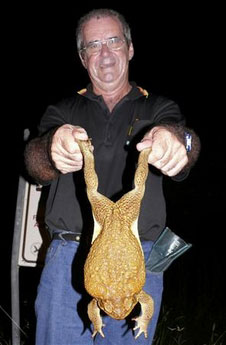Cane toads to invade 2 million square kilometers of Australia
Cane toads to invade 2 million square kilometers of Australia
Rhett A. Butler, mongabay.com
April 3, 2007
Cane toads are dramatically expanding their range in Australia and may eventually double their current extent to occupy over 2 million square kilometers, according to new projections by a team of scientists writing in Proceedings of The Royal Society B: Biological Sciences. The researchers report that the invasive amphibians increasingly occupying zones outside their native conditions, putting native Australian species at ever greater risk.
“Usually invasive range models are based on the conditions found in a species’ native range,” the authors write, but cane toads are continuing to expand into “habitat previously thought unsuitable.”
“Our model suggests that, unless interrupted, cane toads eventually will occupy over 2million km2 of Australia,” they continue. “Moreover, cane toads are predicted to colonize 76% of the Australian coastline. This projection greatly increases the predicted invasion area compared with a prior model… and includes for the first time substantial regions of Western Australia, South Australia and Victoria.”
 Bob Goninon of FrogWatch Australia holds a large cane toad captured near Darwin in Australia’s Northern Territory March 26, 2007. Courtesy of FrogWatch |
“If this range is realized, cane toads would approximately double their current range and triple projections from a model parametrized on their native distribution. Suitable habitat for cane toad colonization is predicted in regions with minimum annual temperatures of less than 5.0°C (e.g. parts of southeastern Australia) and in regions with maximum annual temperatures of greater than 37.0°C (e.g. parts of the Northern Territory). These findings suggest that cane toads are increasingly occupying zones outside their native bioclimatic envelope.”
Introduced from Hawaii in 1935 at the urging of sugar cane growers in Queensland who were suffering from an infestation of crop-damaging beetles, the cane road rapidly established itself as one of the most costly alien invasive species in the history of Australia. Not only did the cane toads fail to control the beetle outbreak — they couldn’t jump high enough to eat the insects — they feasted on Australia’s rare and endemic birds, reptiles, amphibians, and small mammals.
Today the Australian government and environmental groups are aggressively trying to control the expansion of the toads through organized toad round-ups, physical barricades, and mass poisoning.
Cane toads are originally from northern Venezuela and Guyana but the species has become a menace across much of the southern United States, Hawaii, and the Caribbean. The species has gained fame for both its size and toxicity. Some have claimed the frog’s secretions are hallucinogenic but there is no evidence that the species has actually produced any sort of high in humans.
Mark C. Urban, Ben L. Phillips, David K. Skelly, Richard Shine, The cane toad’s (Chaunus [Bufo] marinus) increasing ability to invade Australia is revealed by a dynamically updated range model, Proceedings of the Royal Society B: Biological Sciences, 27 Mar 2007, Page FirstCite, DOI 10.1098/rspb.2007.0114, URL http://dx.doi.org/10.1098/rspb.2007.0114
Related article
Overstaying Their Welcome: Cane Toads in Australia.
About a week ago, an Australian Minister of Parliament from the Northern Territory sparked outrage from animal welfare groups, and probably a chuckle of recognition and commiseration among everyone else, with his comments on cane toads. David Tollner, the lawmaker in question, urged people on Australian radio to club toads to death with golf clubs and cricket bats, remarking these methods were commonplace when he was a young man, and he had partaken in such activities himself. For anyone who has had to deal with these insufferable creatures, they know where Tollner is coming from, even if they do not agree with his method of extermination.